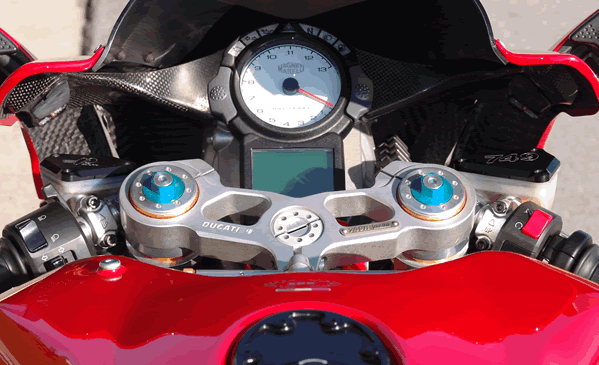
| General Info | Compared to Standard 749 |
| Is the 749R for you? | Horsepower |
| Production Numbers | Common Problems |
| -- | More 749R Resources |
GENERAL INFO
The 749R is a purebred race bike built by Ducati for the special purpose of homologation for SuperSport world championship racing. To those unfamiliar with the term, homologation is the process by which a bike is approved by a racing organization for acceptance into a certain racing class. While there are many racing classes the 749R can qualify for, at the top of the list of Ducati's focus is on its return to and participation at the World Superbike Championship racing series to compete against the mighty Inline-4's from the big Japanese manufacturers. The 749R is, first and foremost, a Racebike before it is a street bike.
Ducati first introduced the 749R in 2004, as the company's highest production V-Twin technology motorcycle. The introduction of this bike brought V-Twin technology very close in performance, power and high-revving behavior to Inline-4 engines only a few years back: while V-Twins are likely to never exceed the power producing characteristics of Inline-4's, the 749R is an amazing accomplishment in mechanical engineering that was previously thought impossible. Out on the track, and in high performance situations, these mechanical advancements will make themselves very clearly known. This awesome evolution of Ducati and the V-Twin engine, along with a congregation of premium suspension and parts, and exclusivity are the most significant aspects of the 749R.
On it's debut year in 2004, the 749R was introduced with full carbon fairings, similar to those found on its big brother, the 999R (which debuted a year earlier). 2004 would be the only year that the 749R would be dressed in carbon fairings, as the succeeding year models would be equipped with a new, high-tech polymer:
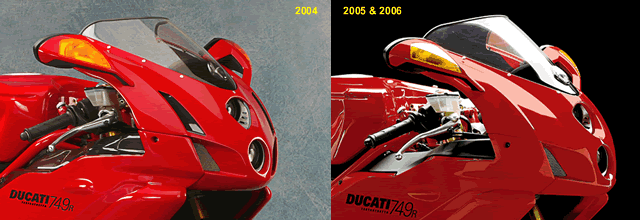
The new plastics that came with the 749R in '05 and '06 are thinner and lighter due to a new and improved manufacturing process. Along with this came a slight change in Ducati's design of the nose piece, which now had only 2 air openings in front (instead of the original 4) and a slightly higher and wider profile. This improved aerodynamics by reducing wind buffeting. The wider profile also provided better positions for the rear-view mirrors which, in the previous model, were more aesthetic than functional.
2005 also introduced a new fender made of the same, new high-tech polymers used for the rest of body. Unlike the 2004 model, which came in clear-coated carbon with embossed Ducati Corse emblem, the new fender came elegantly painted in red with white racing stripe to match the tail section of the bike. Under the clearcoat and boldly in front is the Ducati Corse emblem which, out of Ducati's entire line-up, graces only the "R" brothers.
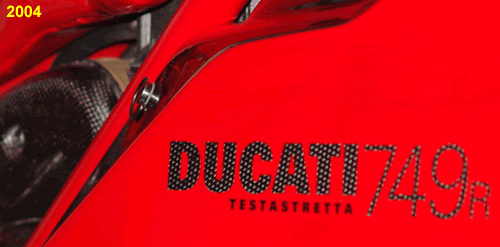
In line with Ducati's previous "R" model bikes with carbon fairings, the 2004 749R carries a "see-through" badge: an unpainted section of the fairing that sees-through to the carbon underneath. Although the succeeding 749R model years did not include this aesthetic feature due to the use of the new polymers, the new 749R badges are colored Black, in contrast to non-R models which are gray in color.
Although the changes in body style and materials used were designed as performance enhancements, collectors find that the original 2004 749R model to be the most desirable of all the 749R's. This can be attributed not only to it being the debut year, but it carried the original nose design and was the only model that came dressed in carbon.
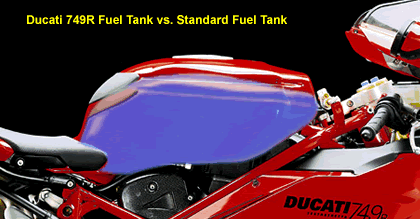
The first 749R also introduced a new, larger and never-seen before fuel tank with 18L (4.8g) capacity - this feature would remain unique to the 749R into the 2006 model year. No other bike in the Ducati's superbike line-up would be equipped with this larger fuel tank, which added approximately 40-50 km (25-30 mi) to the range of the bike.
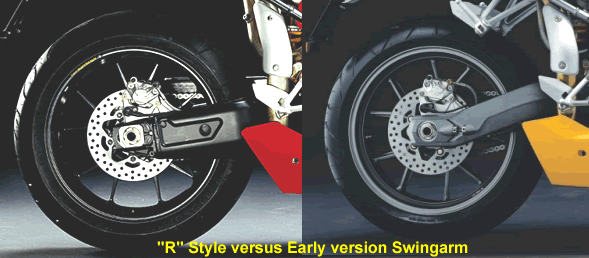
Together with its big brother, the 999R, a unique new "box section" swingarm similar to those used in competition was introduced to the production line-up for the first time in 2004. The design of this new swingarm was well-received by both the street and racing Ducatisti alike, as not only was it lighter, stronger and more rigid, but it was now also possible to fit spools for the use of a rear stand - a lacking feature on previous Superbikes that customers complained incessantly about. The new swingarm was also considered by most to be more aesthetically pleasing, rather than the prior version.
The new swingarm also allowed superbike-type chain adjustment sliders instead of a cam mechanism. This meant that chain tension adjustments would no longer affect suspension. Customers where so pleased with this new swingarm that in the next model year (2005), Ducati made this special part previously equipped only on the "R" brothers, standard to its entire Superbike lineup (with the exception of the 749-Dark, where the "new" R swingarm was made standard in 2006).
Footrests: The 749R has adjustable footrests that can move two positions. This is different from the standard 749 and 749S models that can be adjusted to 5 different positions. The reason for this is to comply with World Supersport regulations. The mounting plates on the 749R are also smaller to allow room for larger diameter exhaust systems.

COMPARED TO THE STANDARD 749
So what do you get for US$8k more with the 749R? First let's list down the most obvious differences in upgraded parts first:
| PART | 749 | 749R | Approx. Upgrade Cost (Retail US$, no labor/tax) |
| FORK | Showa | Ohlins | 2300 |
| REAR SHOCK | Sachs | Ohlins | 1000 |
| STEERING DAMPER | Ducati | Ohlins | 500 |
| FRONT BRAKE | Brembo (Standard) | Brembo (Radial) | 900 |
| CLUTCH | Standard | Slipper | 1200 |
| FUEL TANK | 15.5 L / 4.1 G | 18.3 L / 4.8 G | 2100 |
| WHEELS | Marchesini (Standard) | Marchesini (Forged) | 2500 |
| FAIRINGS & FENDER | Standard | Carbon Fiber (2004 model) | 4200 |
| Head Cover | Aluminum | Magnesium | 250 |
| Belt Cover | Plastic | Carbon Fiber | 300 |
The above list, which does not include all upgrades applied to the 749R yet already amounts to over US $11,000 (not including labor).
In the case of the 2004 749R model, there is a US $4,200 premium on top of that, amounting to over US $15,200 in added upgrade parts. But that is just the visually obvious
Performance-wise, the 749R utilizes unique large titanium valves and rods, a shorter-stroke and increased bore, which allows it to run efficiently at higher RPM and produce substantially more power. With the standard slipper clutch, and unique functionality adjustability of the chassis, what you have is the ultimate track weapon. For those looking for the highest overall performance on the track, the decision is an easy one, and the extra $8k over the standard 749 will seem like a bargain.

On top of this, you have a extra adjustability, unique badges, and a special numbered plate on the Triple Clamps to signify the bike's exclusivity and limited production.
So that's what it is on paper - how about the seat of the pants feel in comparison to the standard bike? Well, when I upgraded from the standard 749 to the 749R, here are some impressions. I noticed:
- The taller tank is immediately noticeable when first sitting on the bike.
- The sound of the engine at idle is more aggressive.
- At neutral, if you twist the throttle, you will also immediately notice a more aggressive throttle response, as the engine revs-up much quicker.
- On a normal street ride, the 749R feels very much like the standard 749, except for a slightly stiffer suspension, which can be adjusted for street use anyway.
- Take the bike to the higher rev ranges and you will feel the R engine and the extra power at the upper end of the rev range. With an upgraded exhaust system, particularly the Termignoni kit, the bike will pull much harder in comparison to standard, as it is able to exert a lot of more horsepower due to the unrestricted movement of exhaust gases.
- The bike has a very distinct and unique high-pitched sound above 9k rpm you will have to experience to appreciate. No other v-twin sounds like it.
- On the mountain roads, there is a large difference between the 749R and standard 749. Perhaps much of it is on account of the lighter wheels, the better suspension and lighter bike overall. Without a doubt, it is a completely different bike that is much more planted, and takes the curves with a type of ease that is unmatched by any production bike of its time. This bike loves to lean and takes curves as easily and naturally as it would coasting down a city street.
HORSEPOWER
The official spec sheets list horsepower in stock form as follows:
- 2004 - 118hp
- 2005 & 2006 - 121hp
These hp figures are measured at the crank. Although there appears to be an improvement in hp in 2005 and 2006, there is no engine difference in the 749R from 2004 through to 2006. The only difference was the way in which hp was measured.
The stock hp figures do not reflect the true potential of the 749R because the stock bike has been restricted to pass stringent emission requirements. The 749R is meant to be run with a free-flowing exhaust that can easily add 20 crank horsepower, which brings it at par with the power of a stock 999.
Rear-Wheel Horsepower.
Although the difference in rear-wheel horsepower can vary greatly from bike-to-bike (dyno-to-dyno, day-to-day, fuel and even tire pressure), ~113rwhp appears to be at the top of the statistical bell curve and is a common number for the stock 749R.
749R's fitted with free-flowing full exhaust systems commonly see 10rwhp over stock measurements, once again depending on many variables. Regardless, a free-flowing exhaust system will transform the 749R from a tame street bike into a track hungry beast.
The 749R is not just a track weapon, but a street-friendly bike as well:
IS THE 749R FOR YOU?
Choosing a bike is always a subjective thing, and if you ask 10 different people which one you should get, you will likely get at least several different answers. So to keep it really simple, the 749R is for you if:
- You want a blue-blooded, no-nonsense, pure-bred race bike
- You want to own (what many claim to be as) the best out-of-the-crate production Track Bike ever built
- You want Ducati's highest superbike V-Twin and Chassis technology, right off the showroom floor
- You want the best parts as standard equipment on a Superbike
- You want an exclusive, numbered Italian superbike
- You want a strong Dealer/Parts/Maintenance support network
PRODUCTION NUMBERS
The 749R was put into production not only as an offering to Ducati's street and track enthusiasts but more so for the purposes of homologation in racing. In the world's biggest SuperSport class race under World Superbike (WSBK) championships, the rules applicable to the 749R are stated as follows:
The overall appearance of a Superbike racing motorcycle, seen from the front, rear and sides, must correspond to that of the bike homologated for use on public roads, with the sole exception of the exhaust system. Since 2004, to balance out the performance of the various engine configurations, differentiated levels of preparation have been permitted. Twins and triples up to 900 cc are allowed to change all the rotating parts in the engine (meaning that only the crankcase, cylinder heads, cylinder blocks and the number of cylinders must remain the same as on the standard bikes). Four cylinder machines are required to use a larger number of roadgoing components (including the crankshaft, and valvegear, etc.). Refuelling or adding oil is not permitted. Supersport bikes must have four stroke engines of between 400 and 600 cc for four cylinder machines, and between 600 and 750 cc for twins. Minimum weight is 162 kg for four cylinder machines, and 170 kg for twins.
Homologation and Minimum Number of machines manufactured:
Supersport: Manufacturers who manufacture more than 75,000 motorcycles a year must produce at least 1000 of the bikes for which they are requesting homologation, while manufacturers who manufacture fewer than 75,000 need only produce at least 500. The same rules governing sale and inspection apply in both Superstock and Supersport.
Superbike: Any bike already homologated for Superstock may, on application from the manufacturer, also be homologated for Superbike at any time.
As far as I have tried to research, exactly how many 749R's were produced in each model year is vague, at best. In my research, I have not come across any official statement on the part of Ducati that states exactly how many were produced.
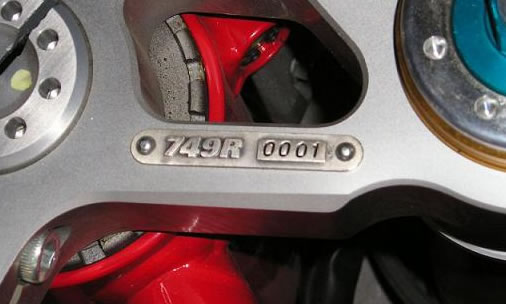
749R's sold at dealerships will have a number stamp on the triple clamp that states the bikes production "number" in 4-digit format. For example, the fifth 749R produced will be marked "749R 0005". While they are numbered, they do not reflect the "0005 of XXXX" or "0005/XXXX" as is traditionally provided on nearly any limited-production item.
When the first 749R was released in 2004, word got around that only 300 of these were produced, and less than 70 of which were transported to North America. And then an extra batch of 100 was produced. In 2005, word got around that 500 were produced for that model year. Over time, I have heard all kinds of production numbers for the 749R, but I am yet to find out for certain, as non are officially verifiable.
According to the applicable WSBK rules stated above (taken from WSBK website in 2006), Ducati must have produced a minimum of 500 749R's in order to fulfill minimum production requirements for homologation (or approval for racing).
It is also unknown how many of the 749R's were sold specifically for racing, some of which may not have been numbered at all.
Without any official statement or some access to Ducati's official production records, we know that at least 500 "should have" been produced by Ducati in order to be approved for racing in WSBK.
COMMON PROBLEMS
2 years after it's first release, there are no major problems, that are at least commonly known for the 749R. Here is a list common issues that are relatively easy to fix under warranty:
- For '04 and '05: Coolant Leak (common on all 749s)
- For '04 and '05: Occasional stalling (common on all 749s)
- Leaking Ohlins Fork Seals (all models) - fixed by replacement of newer, updated seals.
- False Neutrals on downshifting: fixed under warranty
MORE 749R RESOURCES